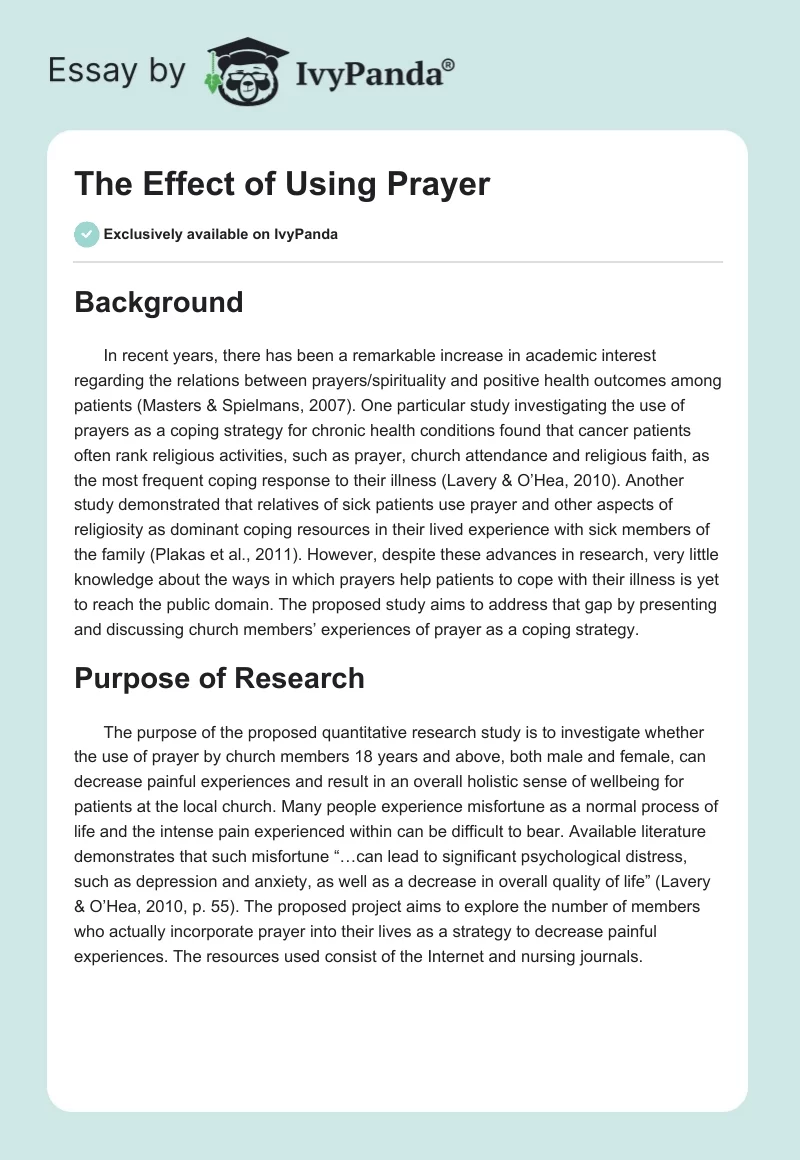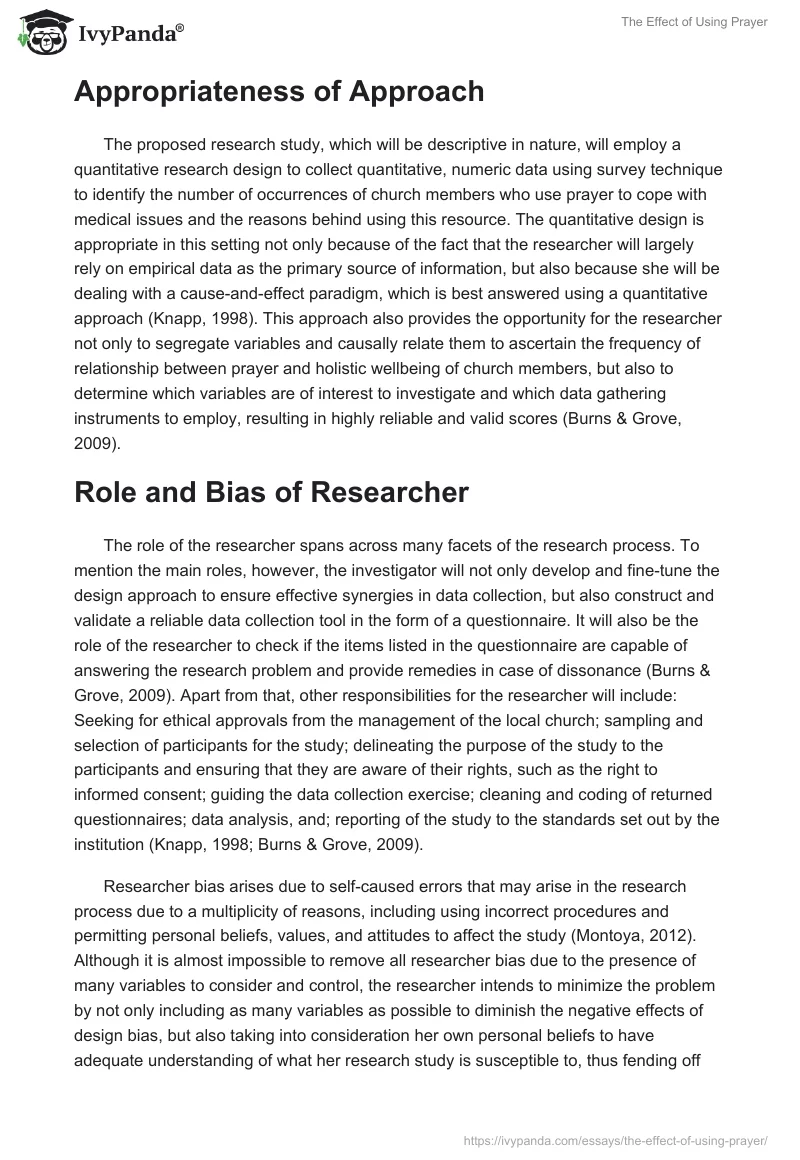Background
In recent years, there has been a remarkable increase in academic interest regarding the relations between prayers/spirituality and positive health outcomes among patients (Masters & Spielmans, 2007). One particular study investigating the use of prayers as a coping strategy for chronic health conditions found that cancer patients often rank religious activities, such as prayer, church attendance and religious faith, as the most frequent coping response to their illness (Lavery & O’Hea, 2010). Another study demonstrated that relatives of sick patients use prayer and other aspects of religiosity as dominant coping resources in their lived experience with sick members of the family (Plakas et al., 2011). However, despite these advances in research, very little knowledge about the ways in which prayers help patients to cope with their illness is yet to reach the public domain. The proposed study aims to address that gap by presenting and discussing church members’ experiences of prayer as a coping strategy.
Purpose of Research
The purpose of the proposed quantitative research study is to investigate whether the use of prayer by church members 18 years and above, both male and female, can decrease painful experiences and result in an overall holistic sense of wellbeing for patients at the local church. Many people experience misfortune as a normal process of life and the intense pain experienced within can be difficult to bear. Available literature demonstrates that such misfortune “…can lead to significant psychological distress, such as depression and anxiety, as well as a decrease in overall quality of life” (Lavery & O’Hea, 2010, p. 55). The proposed project aims to explore the number of members who actually incorporate prayer into their lives as a strategy to decrease painful experiences. The resources used consist of the Internet and nursing journals.
Appropriateness of Approach
The proposed research study, which will be descriptive in nature, will employ a quantitative research design to collect quantitative, numeric data using survey technique to identify the number of occurrences of church members who use prayer to cope with medical issues and the reasons behind using this resource. The quantitative design is appropriate in this setting not only because of the fact that the researcher will largely rely on empirical data as the primary source of information, but also because she will be dealing with a cause-and-effect paradigm, which is best answered using a quantitative approach (Knapp, 1998). This approach also provides the opportunity for the researcher not only to segregate variables and causally relate them to ascertain the frequency of relationship between prayer and holistic wellbeing of church members, but also to determine which variables are of interest to investigate and which data gathering instruments to employ, resulting in highly reliable and valid scores (Burns & Grove, 2009).
Role and Bias of Researcher
The role of the researcher spans across many facets of the research process. To mention the main roles, however, the investigator will not only develop and fine-tune the design approach to ensure effective synergies in data collection, but also construct and validate a reliable data collection tool in the form of a questionnaire. It will also be the role of the researcher to check if the items listed in the questionnaire are capable of answering the research problem and provide remedies in case of dissonance (Burns & Grove, 2009). Apart from that, other responsibilities for the researcher will include: Seeking for ethical approvals from the management of the local church; sampling and selection of participants for the study; delineating the purpose of the study to the participants and ensuring that they are aware of their rights, such as the right to informed consent; guiding the data collection exercise; cleaning and coding of returned questionnaires; data analysis, and; reporting of the study to the standards set out by the institution (Knapp, 1998; Burns & Grove, 2009).
Researcher bias arises due to self-caused errors that may arise in the research process due to a multiplicity of reasons, including using incorrect procedures and permitting personal beliefs, values, and attitudes to affect the study (Montoya, 2012). Although it is almost impossible to remove all researcher bias due to the presence of many variables to consider and control, the researcher intends to minimize the problem by not only including as many variables as possible to diminish the negative effects of design bias, but also taking into consideration her own personal beliefs to have adequate understanding of what her research study is susceptible to, thus fending off cases of bias. Since quantitative bias is a more likely culprit in most research studies, the researcher also needs to be honest with her own opinions on the main issue of interest and always ensure that such opinions do not interfere with the research process (Montoya, 2012).
Sampling Technique
The researcher intends to use purposive sampling to come up with a representative sample of participants for the study. According to Tongco (2007), “…the purposive sampling technique, also called judgment sampling, is the deliberate choice of an informant due to the qualities the informant possesses” (p. 147). It should be remembered that the proposed project aims to explore how members of the local church community incorporate prayer into their lives as a strategy to decrease painful experiences. Consequently, the selected participants must exhibit qualities of prayer/religiosity and experience with painful experience.
Appropriateness of Sampling Technique
Purposive sampling technique is not only easy to employ in the proposed research study as it does not require underlying theories or a set of informants, but provides the researcher with the capacity to find participants who can and are willing to provide the information to answer key research questions by virtue of knowledge or experience to the issue under investigation (Tongco, 2007). Additionally, purposive sampling is less costly, less time consuming, and provides more accurate data because only suitable participants with adequate knowledge of the issue of interest are sampled (Burns & Grove, 2009).
Target Audience/Participants
The participants will be sampled from the local church after seeking permission from the local pastor and other relevant agencies. The criteria for inclusion include: 1) must be 18 years and above, 2) either male or female, 3) well versed with issues of religiosity and spirituality in church setting, 4) must have attended church services at the local church for a period not less than two years, 5) be of any nationality, racial or ethnic grouping, 6) demonstrate evidence of occurrence of painful experiences in own lives or in the lives of close family members, and 7) be ready and willing to take part in the research study.
Hypothesis & Key Research Questions
The selected area of study impacts nursing because anecdotal evidence demonstrates that the process of prayer results in healing and may serve as an alternative means to medical intervention (Head, 2004). Academics have demonstrated that prayer has the capacity to not only decrease anxiety and depression, but also to promote wellness and enhance the overall quality of life (Lavery & O’Hea, 2010). Consequently, a study on this topic is beneficial to nursing practice as it will provide nurse leaders and staff with an avenue to deal with spiritual matters and demonstrate deeper insights into the major impact of prayer on health matters affecting the target group. More importantly, the study findings may assist reinforce the assertions that prayer as a non medical intervention not only facilitates the healing process and serves as a conduit which results in positive health outcomes, but also assists in the patient’s overall plan of care (Head, 2004). Going by these assertions, the proposed study will aim to prove or disapprove the following hypothesis:
H1: The use of prayer initiates a positive coping mechanism to deal with painful experiences and therefore, increases the overall holistic sense of well being among church members of the local church.
The proposed study will be guided by the following research questions:
- How prevalent is the use of prayer related to the healing process of medical conditions among church members aged 18 years and above?
- What roles does prayer have on reducing painful experiences and promoting a holistic sense of wellbeing among church members?
- What circumstances or factors encourage prayer and its healing ability within the organization?
- How can nurse leaders and nurses benefit from using prayer as a facilitation tool in the patient’s healing plan?
Reference List
Burns, N., & Grove, S.K. (2009). The practice of nursing research: Appraisal, synthesis, and generation of evidence. Philadelphia: Saunders/Elsevier.
Head, J. (2004). Please pray for me: The significance of prayer for mental and emotional wellbeing. Web.
Knapp, T.R. (1998). Quantitative nursing research (1st ed.). Thousand Oaks, CA: Sage Publications Inc.
Lavery, M.E., & O’Hea, E.L. (2010). Religious/Spiritual coping and adjustment in individuals with cancer: Unanswered questions, important trends, and future directions. Mental Health, Religion & Culture, 13(1), 55-65.
Masters, K.S., & Spielmans, G.I. (2007). Prayer and health: Review, meta-analysis, and research agenda. Journal of Behavioral Medicine, 30(4), 329-338.
Plakas, S., Boudioni, M., Fouka, G., & Taket, A. (2011). The role of religiosity as a coping resource for relatives of critically ill patients in Greece. Contemporary Nurse: A journal of the Australian Nursing Profession, 39(1), 95-105.
Tongco, M.D.C. (2007). Purposive sampling as a tool for informant selection. Ethnobotamy Research & Applications, 5(1), 147-158. Web.


